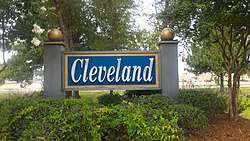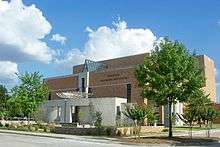Cleveland, Mississippi
| Cleveland, Mississippi | |
|---|---|
| City | |
 | |
 Location of Cleveland, Mississippi | |
 Cleveland, Mississippi Location in the United States | |
| Coordinates: 33°44′31″N 90°43′36″W / 33.74194°N 90.72667°WCoordinates: 33°44′31″N 90°43′36″W / 33.74194°N 90.72667°W | |
| Country | United States |
| State | Mississippi |
| County | Bolivar |
| Area | |
| • Total | 7.3 sq mi (18.9 km2) |
| • Land | 7.3 sq mi (18.9 km2) |
| • Water | 0.0 sq mi (0.0 km2) |
| Elevation | 141 ft (43 m) |
| Population (2010) | |
| • Total | 12,334 |
| • Estimate (2016)[1] | 12,101 |
| • Density | 1,700/sq mi (650/km2) |
| Time zone | Central (CST) (UTC-6) |
| • Summer (DST) | CDT (UTC-5) |
| ZIP codes | 38732-38733 |
| Area code(s) | 662 |
| FIPS code | 28-14260 |
| GNIS feature ID | 0668601 |
| Website | City Website |
Cleveland is a city in Bolivar County, Mississippi, United States. The population was 12,334 as of the 2010 United States Census.
Cleveland has a large commercial economy, with numerous restaurants, stores, and services along U.S. 61. Cleveland is one of the two county seats (the other being Rosedale) of Bolivar County, which was named for the South American liberator Simon Bolivar.
History
Named after President Grover Cleveland, the town began formation in 1869 as people moved inland from the Mississippi River. The Louisville, New Orleans & Texas Railroad ran through the town and a portion of the railroad remains there today. Early records show the community was called Fontaine in 1884 and at some point Coleman's Station. Moses W. Coleman built the first home on the bayou in the area. In 1885, it was officially named Sims after Rueben T. Sims, who owned part of the land on which the town stood. The village of Cleveland was chartered on March 25, 1886, and the United States Post Office recognized the town as such on August 5, 1887. It was Sims's son, B.C. Sims, who was responsible for the name change to Cleveland.
In 1967, Senators Robert F. Kennedy and Joseph S. Clark, Jr. began Senate hearings to assess the effectiveness of the War on Poverty programs. The first field hearings were held in Jackson, Mississippi, and the following day Kennedy and Clark set out to visit "pockets of poverty" in the Mississippi Delta. They arrived in Cleveland, along with Marian Wright and Peter Edelman, for a tour conducted by Amzie Moore. There they observed barefoot, underfed African-American children in tattered clothing, with vacant expressions and distended bellies. Kennedy told Edelman that he thought he had seen the worst poverty in the nation in West Virginia, but it paled in comparison to the poverty he observed in Cleveland.[2]
Geography
According to the United States Census Bureau, the city has a total area of 7.3 square miles (19 km2), all land.
Demographics
| Historical population | |||
|---|---|---|---|
| Census | Pop. | %± | |
| 1900 | 479 | — | |
| 1910 | 1,001 | 109.0% | |
| 1920 | 1,674 | 67.2% | |
| 1930 | 3,240 | 93.5% | |
| 1940 | 4,189 | 29.3% | |
| 1950 | 6,747 | 61.1% | |
| 1960 | 10,172 | 50.8% | |
| 1970 | 13,327 | 31.0% | |
| 1980 | 14,524 | 9.0% | |
| 1990 | 15,384 | 5.9% | |
| 2000 | 13,841 | −10.0% | |
| 2010 | 12,334 | −10.9% | |
| Est. 2016 | 12,101 | [1] | −1.9% |
| U.S. Decennial Census[3] 2012 Estimate[4] | |||


As of the 2010 United States Census, there were 12,334 people residing in the city. 49.9% were African American, 46.8% White, 0.0% Native American, 0.9% Asian, 0.1% Pacific Islander, 0.1% from some other race and 0.6% from two or more races. 1.5% were Hispanic or Latino of any race.
As of the census of 2000, there were 13,841 people, 4,718 households, and 3,132 families residing in the city. The population density was 1,892.2 people per square mile (731.1/km²). There were 4,988 housing units at an average density of 681.9 per square mile (263.5/km²). The racial makeup of the city was 49.90% White, 48.26% African American, 0.12% Native American, 0.99% Asian, 0.02% Pacific Islander, 0.25% from other races, and 0.46% from two or more races. Hispanic or Latino of any race were 0.94% of the population.
There were 4,718 households out of which 31.5% had children under the age of 18 living with them, 41.9% were married couples living together, 21.2% had a female householder with no husband present, and 33.6% were non-families. 27.7% of all households were made up of individuals and 10.5% had someone living alone who was 65 years of age or older. The average household size was 2.60 and the average family size was 3.21.
In the city, the population was spread out with 24.2% under the age of 18, 20.2% from 18 to 24, 24.4% from 25 to 44, 19.7% from 45 to 64, and 11.5% who were 65 years of age or older. The median age was 29 years. For every 100 females there were 83.4 males. For every 100 females age 18 and over, there were 77.3 males.
The median income for a household in the city was $29,466, and the median income for a family was $40,242. Males had a median income of $32,979 versus $23,643 for females. The per capita income for the city was $14,585. About 18.1% of families and 25.5% of the population were below the poverty line, including 30.4% of those under age 18 and 28.8% of those age 65 or over.
Arts and culture
Mississippi Blues Trail
Two Mississippi Blues Trail markers are located in Cleveland. The first marker recognizes Chrisman Street, which once served as the center of African-American business and social life in Cleveland. The second marker celebrates blues musician W. C. Handy.[5]
The Grammy Museum Mississippi opened in 2016.
Education
Colleges and universities
Bolivar County has two community colleges: Coahoma Community College and Mississippi Delta Community College.[6][7] Their main campuses respectively are in unincorporated Coahoma County and Moorhead in Sunflower County.
Public schools
The City of Cleveland is served by the Cleveland School District. Schools within the Cleveland city limits include:
High schools:
Schools will conjoin as Cleveland Central High School starting fall of 2017 due to federal court orders.
Middle schools:
- Margaret Green Junior High School (MGJH)
- D.M. Smith Middle
Schools will conjoin starting fall of 2017 due to federal court orders.
Elementary schools:
- Nailor Elementary School
- Cypress Parks Elementary School
- Pearman Elementary School
- Parks Elementary School
Other:
- Alternative School
- Cleveland Voc Tech Complex
Private schools
K-12:
Elementary-middle school:
- Presbyterian Day School
Media
Newspapers
- The Bolivar Commercial
- The Cleveland News Leader Defunct
- The Cleveland Current
Television
- Channel 6, WABG-TV: ABC
- Channel 9, WHCQ-LD
- Channel 15, WFXW
- Channel 23, WMAO-TV: PBS/Mississippi Public Broadcasting
- Channel 42, W41BV
FM radio
- 90.9 WMAO-FM: Public Radio
- 92.1 WKXY: Country Music
- 92.9 WDTL-FM: Country Music
- 93.9 WGRM-FM: Gospel Music
- 95.3 WRKG: Classic rock
- 96.9 WTCD: Talk Radio
- 98.3 WDFX: Religious
- 99.1 WYMX: Hot AC
- 100.7 WDMS: Country Music
- 102.3 WIQQ: Top 40
- 103.9 WCLD-FM: Urban Contemporary
- 105.5 WDTL: Adult Contemporary
- 106.5 WAID: Urban Contemporary
- 107.5 WMJW: Country Music
AM radio
- 640 WCRV
- 710 KEEL
- 810 WSJC
- 940 WCPC
- 1030 WGSF
- 1090 KAAY
- 1180 WJNT
- 1260 WGVM
- 1410 WDSK : Talk Radio
- 1490 WCLD: Gospel Music
- 1600 WMQM
Infrastructure
Police services
The city of Cleveland is served and protected by the Cleveland Police Department and is located on South Sharpe Avenue. Currently, 45 people are employed by the department. Of the 45, 39 are sworn police officers and six civilians serve in a support role. Sworn officers average out to one officer per 357 citizens.[8]
Fire services
The Cleveland Volunteer Fire Department is currently rated Class 4 by the State Rating Bureau and has three paid employees and 37 volunteer fire fighters. The paid employees include a Fire Inspector, Maintenance Engineer and Maintenance Assistant. All other positions are volunteer. The department operates from three separate fire stations, including a new station at the Cleveland Municipal Airport that opened in late 2011 and utilizes four front line pumpers, two rescue/utility vehicles, an aerial platform pumper, an airport/crash rescue truck, one Ford F-2500 with a bed mounted deluge gun, a Hazardous Materials Response Unit and one backup pumper for its daily operations. The department also operates a training facility that is home to a rope rescue tower, smoke house, ventilation simulator, confined space maze, drafting pit, and a Class A burn facility.
Health care
Bolivar Medical Center is a hospital in Cleveland with emergency services.
Notable people
- Bobby Bradford – American jazz trumpeter, cornetist, bandleader, and composer.
- Amzie Moore – civil rights activist
- Bobbie L. Steele – 32nd president of Chicago's Cook County Board of Commissioners.
- Larry Speakes – acting spokesman for the White House under President Ronald Reagan.
- E. M. Toler – physician, coroner, and member of the Louisiana State Senate from 1944 to 1954; was an educator in Cleveland in his early career[9]
- Professional baseball players: Dave Ferriss, Chet "Chick" Morgan, Josh Hancock and Kevin Rogers.
- Professional football players: Shane Matthews, Floyd Womack, Pat Coleman, Ken Lucas, and Lou Rash, as well as college football coach Pete Hurt.
References
- 1 2 "Population and Housing Unit Estimates". Retrieved June 9, 2017.
- ↑ Schmitt, Edward R. (2011). President of the Other America: Robert Kennedy and the Politics of Poverty. University of Massachusetts Press. pp. 178, 179.
- ↑ United States Census Bureau. "Census of Population and Housing". Archived from the original on May 12, 2015. Retrieved September 2, 2013.
- ↑ "Annual Estimates of the Resident Population: April 1, 2010 to July 1, 2012". Retrieved September 2, 2013.
- ↑ "List of Blues Trail Markers". Mississippi Blues Commission. Retrieved December 2013. Check date values in:
|access-date=(help) - ↑ "Student Residency." Coahoma Community College. Retrieved on July 8, 2017.
- ↑ "Message from the President." Mississippi Delta Community College. Retrieved on July 8, 2017.
- ↑ "Police Department". Cleveland, MS Chamber of Commerce. Archived from the original on 2007-09-27. Retrieved 2007-05-30.
- ↑ Henry E. Chambers, A History of Louisiana, Vol. 2, (Chicago and New York City: The American Historical Society, Inc., 1925), pp. 259–260
Further reading
External links
| Wikivoyage has a travel guide for Cleveland (Mississippi). |
- City of Cleveland
- Cleveland Chamber of Commerce
- Cleveland-Bolivar County Chamber of Commerce/Tourism
